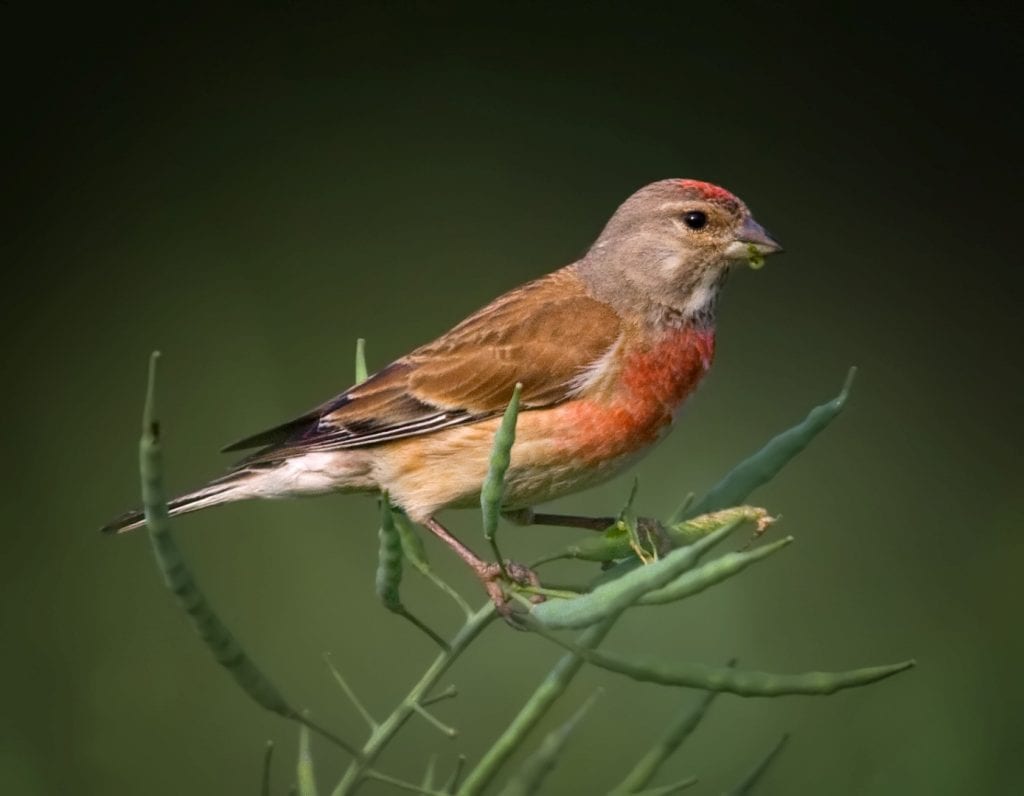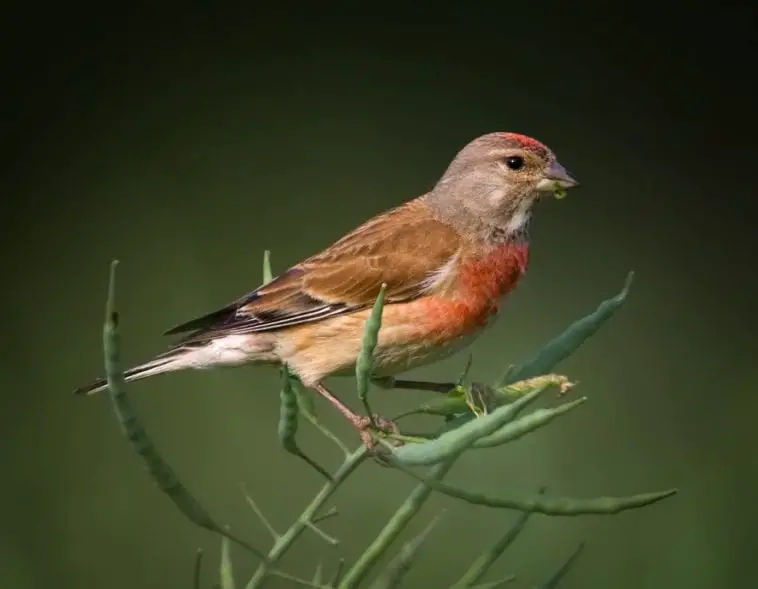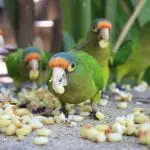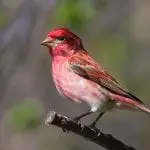Scientific facts
| Scientific name | Linaria cannabina |
| Kingdom | Animalia |
| Phylum | Chordata |
| Order | Passeriformes |

Description
The common linnet is a thin bird with an extended tail. The upper portions are russet, the throat is tarnished snowy, and the bill is grey. The summer male has a grey nape, pink head-patch besides redbreast. Females and new birds absence the red and have snowy underparts, the breast marked toned.
Taxonomy
In 1758 the Swedish biologist Carl Linnaeus comprised the common linnet in the 10th version of his Systema Naturae under the binomial designation, Acanthis cannabina. The type was previously placed in the type Carduelis nonetheless founded on the consequences of a phylogenetic examination of mitochondrial besides nuclear DNA orders available in 2012; it was stimulated to the kind Linaria that had been presented by the German biologist Johann Matthäus Bechstein in 1802.
The type designation linaria is the Latin for a linen-weaver, derived in word Linum, “flax.” The type term cannabina originates from the Latin for hemp. The English term has a comparable root, being resulting in or after Old French Linette, after lin, “flax.”
Distribution
The common linnet strains in Europe, western Asia besides north Africa. It is partly occupant, but numerous eastern and northern birds travel beyond south in the breeding variety or move to the shores. They are occasionally found numerous hundred miles off-coast.
Behavior
Open terrestrial with thick scrubs is favored for breeding, counting heathland, and plot. It builds its nest in a scrubland, placing 4-7 eggs.
This type can form big flocks outdoor the breeding period, occasionally varied with other finches, for example, twite, on coasts in addition to salt marshes.
The common linnet’s enjoyable song covers fast warbles and twitters.
It fodders on the ground, and short down in scrubs, its food mostly containing seeds, which it likewise fodders to its chicks. It likes slight to medium-sized kernels from maximum arable wildflowers, knotgrass, berth), crucifers (counting charlock, shepherd’s purse), chickweeds, dandelions, thistle, sow-thistle, as well as mayweed, common groundsel, common hawthorn besides birch. They take a small constituent of Invertebrates in their régime.
Conservation
The common linnet is registered by the UK Biodiversity Action Plan as an important type. It is endangered in the UK by the Wildlife and Countryside Act 1981.
In Britain, inhabitants are deteriorating, attributed to snowballing usage of herbicides, violent scrub elimination, and extreme hedge trimming; its populace chop by 56% amid 1968 and 1991, perhaps due to a reduction in seed source and the increasing usage of herbicide. From 1980-2009, rendering to the Pan-European Common Bird Monitoring Scheme, the European population reduced by 62%
Favorable management performs on agricultural land comprise:
- Set-aside
- Overwinter growths
- Unrefined margins, ditches, field angles
- Preservation headlands
- Wild bird shelter, using vegetations that crop small, oil-rich seeds, for example, kale, quinoa, the mustard plant then oil-seed rape Brassica napus
- Refurbishment of meadows: renewal and formation of hay-meadows
- Short, dense, thorny hedges and bush for nesting home
- Robert Burns’s moving 1788 verse ‘A Mothers Lament For The Death Of Her Son’ likewise tells of a linnet bird lamenting her overwhelmed young.
Cultural Reference
The bird was a general domesticated in the late Victorian besides Edwardian ages. Alfred, Lord Tennyson references “the linnet born within the cage” in Canto 27 of his 1849 poem “In Memoriam A.H.H.,” the similar segment that covers the well-known lines “‘Tis better to have loved and lost / Than never to have loved at all.” A “cock linnet” structures in the definitive British music hall tune of that period My Old Man, besides as a character in Oscar Wilde’s kids’ story “The Devoted Friend”; Wilde likewise references how the noise of the linnet wakes “The Selfish Giant” to the one sapling where it is season in his plot. William Butler Yeats suggests a copy of the common linnet in The Lake Isle of Innisfree (1890) inline 8: “And evening full of the linnet’s wings.” In the innovative The Old Curiosity Shop by Charles Dickens, the protagonist Nell keeps “only a poor linnet” in a birdcage, which she leaves for Kit as a symbol of her thankfulness to him.
The English Baroque creator John Blow collected a rhyme on the time of the death of his coworker Henry Purcell, “An Ode on the Death of Mr. Purcell” established to the poem “Mark how the lark and linnet sing” by the writer John Dryden.
“The Linnets” has to turn out to be the name of King’s Lynn Football Club, Burscough Football Club, and Runcorn Linnets Football Club (previously recognized as ‘Runcorn F.C.’ and Runcorn F.C. Halton). Barry Town F.C., the South Wales-based football team, likewise used to be labeled ‘The Linnets.’
William Blake appeals to “the linnet’s song” in one of the verses permitted “Song” in his “Poetical Sketches.”
Walter de la Mare’s verse “The Linnet,” available in 1918 in the group Motley and Other Poems, has been customary to a melody by several creators counting Cecil Armstrong Gibbs, Kenneth Leighton besides Jack Gibbons.
The Eurovision Song Contest 2014 entry for the Netherlands The Common Linnets is a straight orientation to the birdie.
William Wordsworth contended that the tune of the common linnet delivers more understanding than records in the third stanza of The Tables Turned.
Fun Facts
- Common linnet can spread 5 inches in the distance and 0.5 to 0.75 ounce of mass.
- Males take the grey head, snowy throat besides reddish-brown fluff on the posterior. Crown and torso are pinkish-red tinted throughout the breeding term. Females are brown colored, somewhat cloudier likened to males. The ventral side of their figure is snowy, with ochre patterns on the chest. Extensions and tail are snowily tinted on the edges.
- Common linnet has a petite grey bill, thin body, and extended cleft tail.
- Common linnet has a wingspan of 8.5 to 10 inches, and it has rolling flying.
- Common linnet is an omnivore (it consumes equally vegetations and meat). The mainstream diet is founded on the kernel. Common linnet eats the kernel of 46 dissimilar types of plants, typically from a cabbage domestic. It irregularly searches and consumes small invertebrates (for example, insects).
- The scientific term of common linnet, “Carduelis cannabina,” mentions to the feeding conducts of this bird and its love for hemp (diversity of cannabis). The common term “linnet” mentions a liking for flaxseed, that is used in the production of linen.
- Common linnet survives in big flocks (frequently assorted with another type of finch) outside the breeding period.
- Eastern and northern inhabitants of common linnets travel to the south throughout the autumn.
- Common linnet crops melodic, enjoyable songs that contain fast warbles and twitters.
- The mating period of common linnets takes dwelling from April to August. Common linnets animate in minor colonies (about 20 individuals) throughout the breeding period.
- Common linnets mate with lone one partner throughout the breeding period (monogamous birds) and yield 2 to 3 young per year.
- Common linnet builds cup-shaped layers completed of grass and branches in the scrubs and prickly trees.
- Female places 4 to 6 light blue eggs with purple and russet spots. Offspring hatch after 11 to 13 days. The only female takes portion in the gestation of eggs.
- Equally, parents gather and bring kernel (the basic basis of nourishment for the chicks) to the nest. Chicks are prepared to leave the layer at the stage of 11 to 17 days. Common linnets spread sexual adulthood at the stage of one year.
- Common linnet can endure equally to 8 years in the desolate (2 years is a regular lifetime).
Common Diseases
Avian Polyomavirus
Avian polyomavirus (APV) chiefly distresses young birds. There are two main systems of the illness based on type affected: budgerigar fledgling illness and a nonbudgerigar polyoma contagion. Both are branded by peracute to the severe passing of preweaned neonates. Adult birds classically are resistant to contagion; they will seroconvert besides shedding the virus for able to 90 days, then clear the contagion. The development period is 7–10 days.
The typical performance of budgerigar fledging illness is a well-fleshed early, just beforehand fledgling stage, with the severe onset of weariness, crop stability, and death in 24–48 hr. Other scientific signs are cutaneous outflow, stomach distention, and feather irregularities. Living budgerigars >3 wk old frequently display feather dystrophy (French molt or quill dusters). In another type of psittacines <4 mo old, the contagion is likewise frequently fatal. Older nonbudgerigar psittacines may have a subclinical disease or hemorrhages and coagulopathies. Prevalence of the virus in adult psittacines, including budgerigars, is thought to be high.
The antemortem analysis is proficient with DNA investigations of the cloacal swab, then plasma samples, and virus-neutralizing antibody examinations of blood examples to recognize birds with preceding viral contact. Analysis in a flock setting is characteristically founded on scientific signs, signalment, and necropsy results.
Gross necropsy conclusions in dead chicks frequently comprise light skeletal musculature and hypodermic ecchymotic hemorrhages. The kidneys besides the liver are distended and might be pale, overfilled, and dappled, or have pinpoint, snowy foci. Petechial or ecchymotic hemorrhages might likewise be present on viscera, chiefly the heart. The heart is occasionally distended and might display hydropericardium. Intranuclear presence bodies are frequently understood in the liver, kidneys, heart, spleen, as well as bone marrow, uropygial gland, skin, and feather follicles, etc.
Aviary control approaches comprise avoiding the covering of budgerigars or lovebirds on grounds where other types are bred, following to typical hygiene actions, stopping admittance to the nursery by guests, and not presenting natures into the aviary deprived of 90 days isolation and testing. Removing APV infection from an ill budgerigar aviary is stimulating. Primary, all breeding must be stationary for 6 mo.
The attendance of infected neonates, novices, and adults spreads the illness. Throughout this time, adult birds are enthused to a noninfected part while the complete aviary is clean. Nest boxes must be clean or castoff and replaced. After 6 mo, mature breeding birds can be repaid to a spotless aviary and breeding recommenced.
Pet store deterrence should comprise separating neonates from diverse bases, obtaining birds from bases where polyomavirus challenging and inoculation are done, and preferably, not purchasing or marketing unweaned birds.
Treatment is helpful care. A vaccine is obtainable. For breeding birds, 2 amounts of the vaccine are managed at a 2-wk intermission; this should be completed off-season. The producer endorses management of the first dosage when the chick is >35 days old, with a booster inoculation in 2–3 wk.
Image Source http://www.oiseaux-birds.com/card-common-linnet.html
Psittacine Beak and Feather Disease
Psittacine beak and feather disease (PBFD) is produced by a psittacine circovirus. The disease was first documented in the 1970s in cockatoos with beak besides feather cuts. Meanwhile then, it has been documented in the most class of parrots and likewise in Passeriformes and Columbiformes. Diseased birds shed disease in their fluffs, feather dander, feces, besides oral oozes. Transmission happens by inhalation and/or digestion of the disease and can happen vertically. The disease is very steady in the setting, so fomites can be an important basis of contamination.
The name is not as distinguishing of the present characteristic clinical performance, which often does not include beak irregularities and is less probable to have the severe, definitive feather irregularities perceived in cockatoos when the illness was first recognized. The use of screening PCR examinations has greatly reduced the occurrence of the virus in confined bred Cacatua spp. Though the illness is still perceived in African grey parrots, Eclectus parrots, lovebirds (Agapornis), lorikeets, and other types, nonetheless, are rare. The natural contagion seems to occur mainly in juvenile birds, with insufficient examples of clinical contagion perceived in birds >3 yr old.
In the classic PBFD contagion, the first sign of the existence of illness is a deficiency of powder down on the beak. The disease causes irregular development of mounting feathers and immunosuppression. Feathers are strained or battered at their base and might have hemorrhage inside the emerging shaft. The fluffs fall out with no trouble and produce back gradually or not at all. The circulation of affected fluffs is contingent on the stage of the bird and the phase of the molt when infested. Pigment damage may happen in colored fluffs.
The bird might live with these cuts for months to years. As the illness develops, the immune system is affected, besides most birds expire of subordinate contagions. A peracute procedure of the illness happens in young birds, which grow enteritis besides pneumonia, lose heaviness, and decease. African grey parrots might grow pancytopenia since the disease bouts the bone marrow. These birds expire abruptly with viral presences in the thymus, bursa, besides bone marrow.
The analysis is based on medical arrival; outcomes of PCR testing of stool, feather dander, or plasma; and operation of affected feather sacs presenting basophilic intracytoplasmic enclosures. Testing by PCR might notice contagion in birds that still look healthy. These birds might then become ill or might mount an actual response to the disease. Because of the constancy of the disease, PCR examination can likewise be used for ecological testing. Isolation besides retesting is optional for PCR-positive, asymptomatic birds. At necropsy, affected birds frequently have no gross cuts inside, nonetheless, intranuclear or intracytoplasmic presences might be perceived histologically in the fluffs, bursa, thymus, liver, or additional organs.
There is no exact handling for PBFD, and the conduct of infected birds is helpful. The transmissible nature of PBFD and its usually fatal consequence in clinically affected birds permit separation and ultimate euthanasia in maximum clinical cases. Severe cleanliness with care to dust control, screening procedures counting PCR testing of together birds and the situation, and lengthy isolations are highly suggested in breeding amenities with vulnerable species. All new vulnerable birds should be verified beforehand introduction to the birdcage. In infected breeding gatherings, eliminating all eggs for cleaning and reproduction gestation may also be compulsory. Since the expansion of a PCR-based examines, the occurrence of the illness has decreased.
Availability and where to get
There are specialized pet shops that cater to different kinds of birds. You can also ask your vet as well as bird breeders for more recommendations and referrals.
Care sheet
Feeding
Balanced food is the most significant portion of a strong bird’s life. The common difficulties that are understood by veterinarians comprise obesity, egg binding besides vitamin A absence.
Several birds are nourished seed as their solitary diet: birds favor this as it is stimulating to open and frequently high in fat, consequently delicious. Nonetheless, dried, packed seeds are low in vitamins (particularly A); some seed combinations cover added vitamins than minerals, though, in some circumstances, birds just eat around these “vitamin balls.” Numerous birds likewise choice only 1 or 2 kinds of seed in the whole combination and will not eat any additional food or seed.
Maximum commonly particular are sunflower kernels or oats (reflect of these seeds as chocolate). To deliver balanced nourishment, numerous other foods need to be obtainable day-to-day. Vegetables, particularly green vegetables, are very vital. Good instances of green vegetables contain spinach, silverbeet, endives, parsley besides celery. Fresh grasses, milk thistle, dandelion besides fresh fruits are likewise inordinate. Good class bird pellets can be used in its place of the kernel.
Cages
Birdcages are home to defend birds, not an enclosure to detain them. Pet birds need defense when their holders are gone, from additional marauders and from the venoms and other hazards that might be part of or about the household.
A birdcage should be four-sided rather than at least sufficient complexity for 2 birds to spread their wings completely. Birds are not helicoptering, so high cages are not suitable. Birds should devote the all-out quantity of time oversaw outside their birdcage to get fit exercise. Deprived of this, birds turn out to be overweight and unhappy. If you are worried about catching your birdie or if it is unwilling, just dim the lights, and the birdie will be easier to clasp.
Perches
Poor roosts normally lead to wounds on bird’s feet. In the previous sandpaper was suggested to cut nails; all it achieves to do is source painful feet. Roosts should be completed of natural timber branches of variable dimensions and not doweling or pliable.
Food and water bowls
Nourishment and water dishes should be located in birdcages where the bird will not excrete in them. If your birdie has parasites or somewhat kind of microbial contagions, they will not recover if your bird reliably eats and drinks their feces. It is finest not to place any resources on the ground that inspires your birdie to eat off the ground. (e.g., sandpaper, grit or food). In its place, custom a grill to permit feces to fall concluded or plain newspaper. Also, evade using metallic toys or malleable coated carrier ties in the birdcage as these may principal to heavy iron poisoning.
Birdcages besides aviaries should be completed of stainless steel, dust-baked, or the new BHP polymer-covered cable. Scrub galvanized cable with vinegar besides a wire brush, then solution the vinegar off besides repeat; this will help minimize the zinc poisonousness nonetheless will not remove it. Weathering the cable (leaving it outdoor to the rudiments) will not cleanse the metal moreover.
Mate or bonding contact
Maximum parrots animate in large flocks. They do not animate in a minor cage. Birds, different dogs besides cats, turn out to be attached to one extra bird or human as a friend. Birds that continuously call, talks besides sings are difficult the care it craves. It is a very infrequent incidence for a bird to be content on its own. Numerous bird diseases and frequent indications in birds are connected to pressure, prevention, and bored parrots. TV and radios are infrequent ease; nonetheless, they are not long-term alternates for company.
FAQ Section
What kind of bird is the calmest to care for?
Top 3 ‘Starter’ Birds
Finch: Finches are countless, cheap, and relaxed to care for; however, it is finest to get them in couples, as they like feathery friends.
Canary: The canary has long subsequently been phased out of the firewood mine.
Budgerigar: The budgie, likewise recognized as the parakeet, is truly the world’s second least parrot.
Do birds get devoted to their owners?
Bird owners that take individual domesticated animals have observed their bird’s attachment with another domesticated animal in the family. Perceiving these ties permit bird owners to become acquainted with the feelings and dispositions of their bird that can vary from enthusiasm to solitude, pressure, and happiness.



